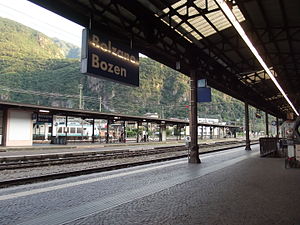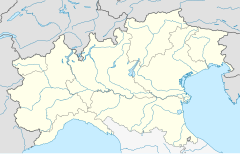Bolzano/Bozen railway station
Bolzano/Bozen | |||||
|---|---|---|---|---|---|
 View of the station from the platforms. | |||||
| General information | |||||
| Location | Piazza della Stazione 1 / Bahnhofplatz 1 39100 Bolzano-Bozen BZ Bolzano, South Tyrol, Trentino-Alto Adige/Südtirol Italy | ||||
| Coordinates | 46°29′48″N 11°21′30″E / 46.49667°N 11.35833°E | ||||
| Operated by | Rete Ferroviaria Italiana Centostazioni | ||||
| Line(s) | Verona–Innsbruck Bolzano/Bozen–Merano/Meran Bolzano/Bozen–Malles/Mals | ||||
| Distance | 150.23 km (93.35 mi) from Verona Porta Vescovo | ||||
| Platforms | 7 for long distance 4 bay platforms (1 for regional trains) | ||||
| Train operators | Trenitalia | ||||
| Connections |
| ||||
| Construction | |||||
| Architect | Angiolo Mazzoni | ||||
| Other information | |||||
| Classification | Gold | ||||
| History | |||||
| Opened | 16 May 1859 | ||||
| Rebuilt | 1927-1929 | ||||
| |||||
Bolzano/Bozen railway station (IATA: BZQ) (Template:Lang-de; Template:Lang-it) serves the city and comune of Bolzano/Bozen, in the autonomous region of Trentino-Alto Adige/Südtirol, northeastern Italy. Opened in 1859, the station forms part of the Brenner railway (Verona–Innsbruck) and also a junction of two branch lines to Merano/Meran and Malles/Mals.
The station is currently managed by Rete Ferroviaria Italiana (RFI). The commercial area of the passenger building, however, is managed by Centostazioni. Train services to and from the station are operated by Trenitalia. Each of these companies is a subsidiary of Ferrovie dello Stato (FS), Italy's state-owned rail company.
Location
Bolzano/Bozen railway station is situated at Piazza della Stazione / Bahnhofplatz, at the southeastern edge of the city centre and a short, 3-minute walk to the city centre.
History
The station was opened on 16 May 1859, upon the completion of the Trento-Bolzano/Bozen section of the Brenner Railway from Verona. At that time, the city was under the rule of the Austrian Empire and known solely as Bozen by the German-speaking population. The station carried the name Bahnhof Bozen-Gries. The passenger building was designed by the Bozner architect Sebastian Altmann.
In 1864, construction began on the final section of the Brenner railway between Bolzano/Bozen and Innsbruck and was completed on 24 August 1867. In 1871, rail services in the area were enhanced by the inauguration of the Puster Valley railway, which connected Bolzano/Bozen to Maribor/Marburg in today's Slovenia through San Candido/Innichen and southern Austria. The Brenner and Puster Valley railways provided Bolzano/Bozen direct links with numerous cities in central Europe and benefited the local economy of crafts, industries and commercial enterprises.
In 1881, a third railway line, Vinschgau Railway, joined the Bolzano/Bozen station and connected it to Merano/Meran. In order to cater for freuqent holiday makers, the Vinschgau line was extended 1906 from Merano to Malles/Mals.
Between 1898 and 1974, Bolzano/Bozen was also the terminus of the Überetsch Railway to Caldaro/Kaltern.
Transfer to Italy
After the World War I, the Treaty of Saint-Germain-en-Laye (1919) assigned the region south of the Brenner Pass to Italy. As a result, Bolzano/Bozen-Gries station became a part of the Italian railway network and came under the management of the FS.
Between 1927 and 1929, the station is replaced by a passenger building in the style of Italy's fascist regime and designed by the architect Angiolo Mazzoni. The facade on the access road to the station was reworked into two half-columns and flanked by two statues, crafted by the Austrian artist Franz Ehrenhöfer, that represent electricity and steam. Ehrenhöfer also produced for the station masks on the cornices of the complex, a fountain with St. Christopher, and an allegory of the Adige river to be placed above the entrance to the clock tower (east of the station).
Features
The passenger building hosts the main ticket office, a Deutsche Bahn ticket office and a waiting room. Other facilities include a cafe bar and a newspaper store. There are six platforms for passenger service and additional tracks for freight traffic.
Passenger and train movements
The station has 5.5 million passenger movements per year and is therefore the busiest within the region in terms of passenger numbers.[1]
Train services

All scheduled passenger trains passing through Bolzano/Bozen, including EuroCity and Eurostar Italia (now Trenitalia Freccia) trains, but except the Venice Simplon Orient Express and DB CityNightLine night trains in the direction of Munich, call at the station. The main domestic destinations are Verona and Trento, but passengers also depart for and arrive from farther afield: Florence, Milan or Rome. The main cross-border links are Munich and Innsbruck.
Since 2010, the station has been a stop for the weekly EuroNight train of Russian Railways between Moscow and Nice.
Germany/Austria/South Tyrol
(D for Germany, A for Austria)
- Night Train (DB CityNightLine) Munich-Rome/Milan: Munich (D) - Rosenheim (D) - Kufstein (A) - Wörgl (A) - Jenbach (A) - Innsbruck (A) - Bressanone/Brixen - Bolzano/Bozen - Trento/Trient - Verona^ - Bologna - Florence - Chiusi Chianciano - Rome
- Intercity Train (ÖBB Eurocity) Munich-Verona/Venice: Munich (D) - Rosenheim (D) - Kufstein (A) - Wörgl (A) - Jenbach (A) - Innsbruck (A) - Brennero/Brenner - Fortezza/Franzensfeste - Bressanone/Brixen - Bolzano/Bozen - Trento/Trient - Rovereto/Rofreit - Verona - (Padua) - (Venice)
- Intercity Train (ÖBB Eurocity) Munich-Verona/Bologna: Munich (D) - Rosenheim (D) - Kufstein (A) - Wörgl (A) - Jenbach (A) - Innsbruck (A) - Brennero/Brenner - Fortezza/Franzensfeste - Bressanone/Brixen - Bolzano/Bozen - Trento/Trient - (Rovereto/Rofreit) - Verona - (Bologna)
- Regional Train (Trenitalia Regional Express or Regional) Brennero/Brenner-Merano/Meran: Brennero/Brenner - Vipiteno/Sterzing - Campo di Trens/Feiernfeld - Fortezza/Franzensfeste - Bressanone/Brixen - Chuisa/Klausen - Bolzano/Bozen - Terlano/Terlan - Merano/Meran
- Regional Train (Südtirol Bahn Regio-Express) Bozen-Innsbruck: Bolzano/Bozen - Bressanone/Brixen - Fortezza/Franzensfeste - Brennero/Brenner - Innsbruck
^ Train connects at Verona with ÖBB EuroNight Vienna-Milan
Italy
- High-speed Train (Trenitalia Frecciargento) Bolzano/Bozen-Naples: Bolzano/Bozen - Trento/Trient - Rovereto/Rofreit - Verona - Bolonga - Florence - Rome - (Naples)
- Regional Train (Trenitalia Regional Express or Regional) Brennero/Brenner-Bologna: Brennero/Brenner - Vipiteno/Sterzing - Campo di Trens/Feiernfeld - Fortezza/Franzensfeste - Bressanone/Brixen - Chuisa/Klausen - Bolzano/Bozen - Ora/Auer - Mezzocorona/Kronmetz - Trento/Trient - Rovereto/Rofreit - Ala/Ahl-am-Etsch - Verona - Isola della Scala - Nogara - Ostiglia - Mirandola - Bologna
- Regional Train (Trenitalia Regional) Bolzano/Bozen-Ala/Ahl-am-Etsch: Bolzano/Bozen - Laives/Leifers - Ora/Aura - Egna/Neumarkt - Salorno/Salurn - Mezzocorona/Kronmetz - Trento/Trient - Rovereto/Rofreit - Mori/Moor in Tirol - Ala/Ahl-am-Etsch
- Regional Train (Trenitalia Regional) Bolzano/Bozen-Bassano del Grappa: Bolzano/Bozen - Ora/Auer - Trento/Trient - San Cristoforo al Lago-Ischia - Bassano del Grappa - (Castelfranco Veneto) - (Venice)
Cross-border
(A for Austria, F for France, CZ for Czech Republic, PL for Poland, BR for Belarus, R for Russia, MN for Monaco)
- Intercity Train (RZD EuroNight) Moscow-Nice: Moscow (Belorusskaja) (R) - Wjasma (R) - Smolensk (R) - Orscha Central (R) - Minsk (BR) - Brest Central (BR) - Terespol (PL) - Warsaw West (Wschodnia) (PL) - Warsaw Central (Centralna) (PL)- Katowice (PL) - Zebrzydowice (PL) - Bohumin (CZ) - Breclav (CZ) - Vienna/Wien (A) - Linz-Donau (A) - Innsbuck (A) - Bolzano/Bozen - Verona - Milan - Genoa - San Remo - Ventimiglia - Menton (F) - Monaco Monte-Carlo (MN) - Nice (F)[1]
See also
- History of rail transport in Italy
- List of railway stations in Trentino-Alto Adige/Südtirol
- Rail transport in Italy
- Railway stations in Italy
References
Notes
- ^ "Flussi Annui nelle 103 Stazioni". Centostazioni website (in Italian). Centostazioni. Retrieved 4 December 2010.
{{cite web}}: Unknown parameter|trans_title=ignored (|trans-title=suggested) (help)
Further reading
- Baumgartner, Elisabeth (1989). Eisenbahnlandschaft Alt-Tirol - Verkehrsgeschichte zwischen Kufstein und Ala im Spannungsfeld von Tourismus, Politik und Kultur (in German). Innsbruck: Haymon. ISBN 3-85218-065-1.
{{cite book}}: Unknown parameter|trans_title=ignored (|trans-title=suggested) (help) - Mitterer, Wittfrida (2007). Scambi & simboli - paesaggio ferrovia Bolzano-Innsbruck. Memorie e volumi in rilievo (in Italian). Bolzano: Athesia. ISBN 978-88-8266-441-1.
{{cite book}}: Unknown parameter|trans_title=ignored (|trans-title=suggested) (help)
External links
- Centostazioni: Information about Bolzano/Bozen railway station Template:It icon
- Description and pictures of Bolzano/Bozen railway station Template:It icon
This article is based upon a translation of the Italian language version, and incorporates information from the German language version, as at December 2010.

